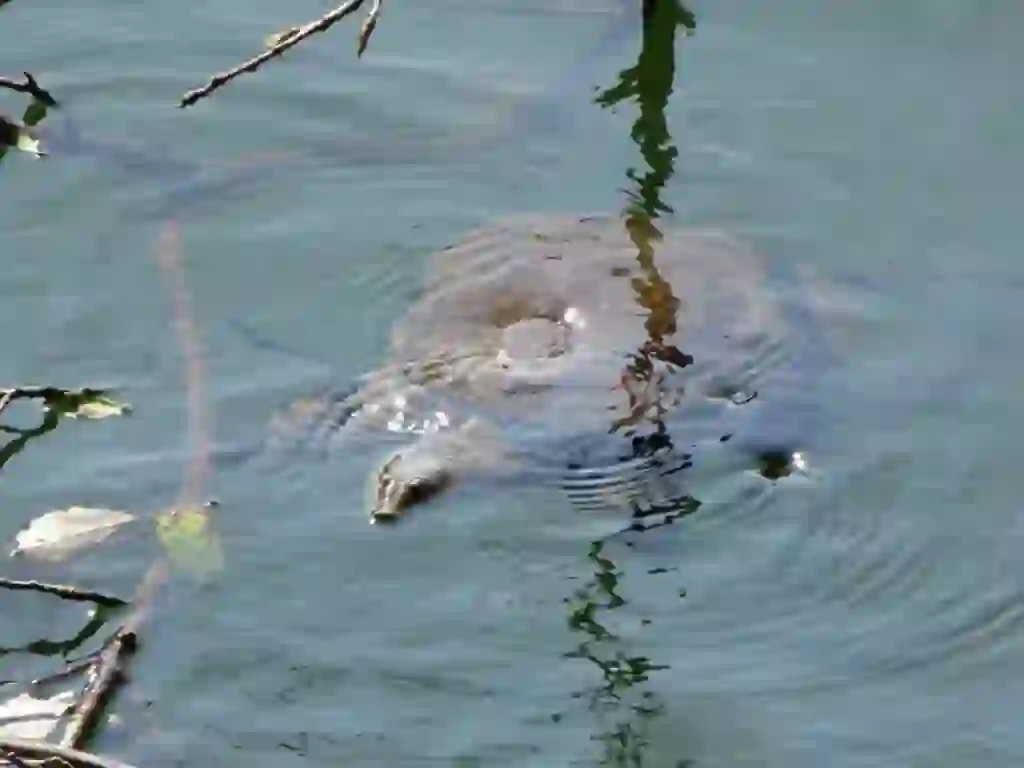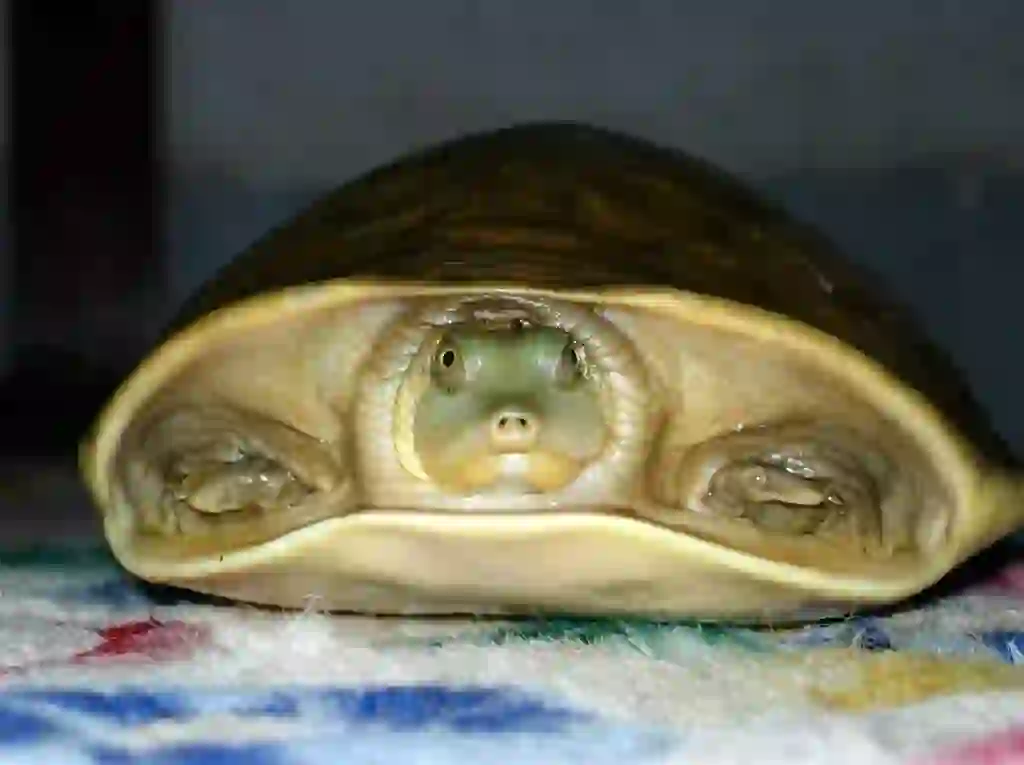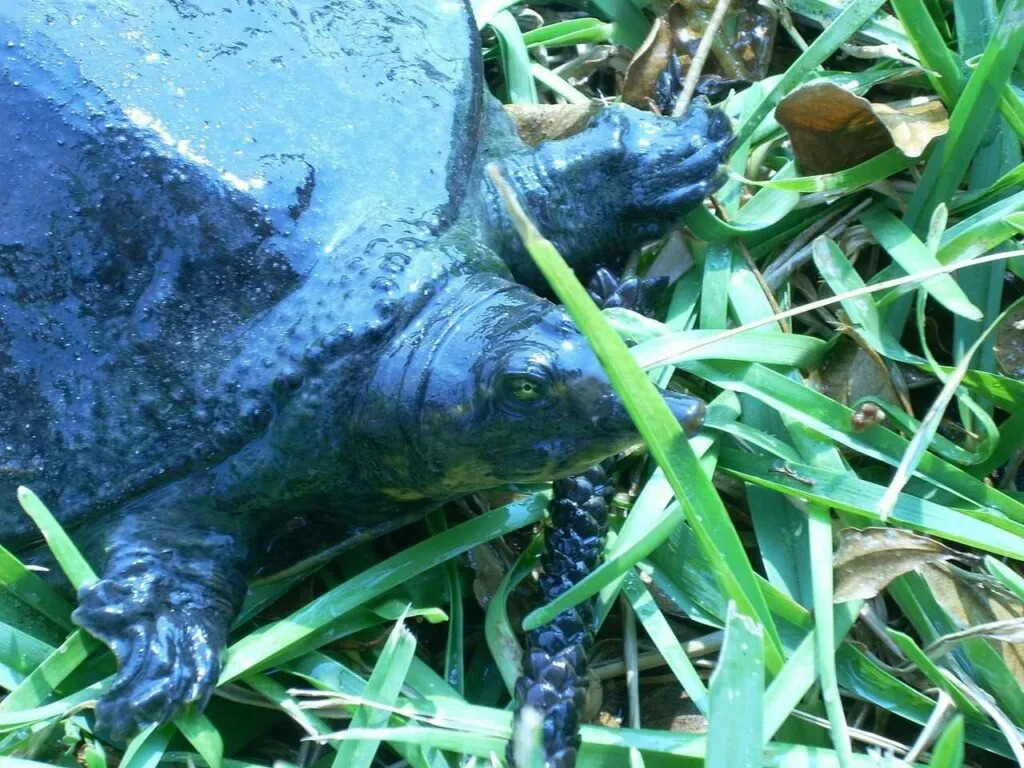
Soft-shelled Turtle
Soft-shelled Turtle
Soft-shelled Turtle
Many people may not distinguish a soft-shelled turtle from a regular turtle! Additionally, it often carries the frightening image of never letting go once it bites. However, soft-shelled turtles are actually very familiar and interesting creatures! In this article, let's explore the unique features and secrets of soft-shelled turtles!
Soft-shelled Turtle Basic Infomation

Class: Reptilia, Order: Testudines, Family: Trionychidae, Genus: Trionyx
Shell length: 25–30 cm (both male and female), Weight: up to about 7 kg
In Japan, it is found in Honshu, Shikoku, Kyushu, Okinawa Island, Ishigaki Island, Iriomote Island, and Yonaguni Island.
Outside Japan, it is said to be distributed in China, the Korean Peninsula, southeastern Siberia, Taiwan, and northern Vietnam.
The back shell part is very flat and covered with soft skin without any scutes.
The tip of its nose protrudes, and it can often be seen hiding in the sand or mud at the bottom of the water, with only its nose sticking out.
Soft-shelled turtles also bask in the sun, so you might see them sunbathing on their shells near rivers.
They are very timid creatures and are highly sensitive to noises, quickly diving back into the water when approached.
They mate from April to June and lay eggs from June to August. The eggs are spherical, about 2 cm in size, and each mating can result in laying 10 to 40 eggs.
Soft-shelled Turtle Q&A

What is the origin of the name 'Soft-shelled Turtle'?
There are various theories about the origin of the name 'soft-shelled turtle'. This turtle is very timid and quickly dives into the water when sensing the presence of other creatures.
The name is believed to have originated from the behavior of diving into the water so swiftly, often described as 'diving in like a soft-shelled turtle'.
Previously, it was also known as 'Drogame', but it has been called 'soft-shelled turtle' since the Edo period.

Why do soft-shelled turtles live there?
Soft-shelled turtles are not only found in Japan but also inhabit areas in China and the Korean Peninsula.
The exact natural distribution of soft-shelled turtles is not well understood. While there are native species, it is thought that many are either escapees from captivity or have been introduced from abroad, leading to potential hybridization.
Furthermore, the soft-shelled turtles in the southwestern islands are considered to have been artificially introduced from China, and studies are still being conducted to trace their origins.

What do soft-shelled turtles eat?
Soft-shelled turtles are carnivorous, feeding on crustaceans, fish, amphibians, and plants.
In captivity, they are fed commercially available pellet food, but also consume mealworms, bloodworms, and snails.

Do soft-shelled turtles not let go once they bite?
There is a saying that a soft-shelled turtle will not let go until it thunders. In reality, while soft-shelled turtles can clamp down hard and not easily release their bite, it's not true that they wait for thunder to let go. The strong jaw can pull back into the shell while biting, so if you ever get bitten, calmly place the turtle back into the water without panicking.

What is the difference between soft-shelled turtles and other turtles?
Many people find it difficult to distinguish between soft-shelled turtles and other turtles. The main difference is that the shell of a soft-shelled turtle is softer and flatter compared to other turtles.
Additionally, soft-shelled turtles have visible stripes on their necks, three toes (compared to five in other turtles), and a thicker, longer tail.

Why are soft-shelled turtles expensive?
Soft-shelled turtles are known as a luxury food ingredient, but they can also be seen swimming in rivers.
The high price is attributed to the variability in taste between individuals, susceptibility to disease, and the common use of farmed turtles. Farming soft-shelled turtles is not only limited in scale but also takes two to three years before they are suitable for consumption. Additionally, culinary preparation of soft-shelled turtles requires specialized skills, contributing to the high cost of dishes.

Are soft-shelled turtles tasty?
Despite being a type of turtle, which might suggest an unpleasant taste, soft-shelled turtles prepared by skilled chefs are delicately processed to be delicious.
Their meat is similar to chicken, lean and favored by many. While their blood is also considered tasty, it has a unique flavor that may not appeal to everyone.

What are the nutritional benefits of soft-shelled turtles?
Soft-shelled turtles are rich in collagen, vitamins B1 and B2, protein, and fats, making them a renowned ingredient for vitality and health.
Except for the shell, claws, bladder, and gallbladder, all parts of the soft-shelled turtle are edible and highly valued.

What is the lifespan of a soft-shelled turtle?
Soft-shelled turtles, being a type of turtle, are known for their longevity. They have an average lifespan of about 30 years, but some have been known to live up to 100 years.
However, those used for culinary purposes are generally consumed at 2 to 3 years old, so they do not live out their potential lifespan.

Can soft-shelled turtles be kept as pets?
It is possible to keep soft-shelled turtles in a home setting. They can eat commercial turtle food as well as mealworms and snails, making feeding relatively simple.
However, baby turtles start small, about 3 cm in length, but can grow to about 30 cm. Adequate space and housing are necessary for home care.
Keep in mind that if temperatures drop below 20 degrees Celsius, a hibernation setup is necessary, and they also need space for sunbathing or a UV light.

Do soft-shelled turtles become affectionate?
Soft-shelled turtles are very timid by nature. They may bite if frightened and are unlikely to become affectionate pets.
However, they may recognize someone who feeds them regularly, associating them with food.

Would you like to become a part of the 'Animalbook.jp'?
Turn your knowledge into Q&A and share it with the world. ※Publication will be activated after purchase. Let's share information together!
Soft-shelled Turtle Type of List

- Nubian Softshell Turtle
- Senegal Softshell Turtle
- Aubry's Softshell
- Zambezi Softshell Turtle
- Indian Flapshell Turtle
- Burmese Flapshell Turtle
- Indochinese Giant Softshell
- Ganges Softshell Turtle
- Peacock Softshell Turtle
- Reeves' Softshell Turtle
- Black Softshell Turtle
- Long-necked Softshell Turtle
- Indian Narrow-headed Softshell
- etc.
Information
Congratulations! You are the first commenter!

Create Your Favorite List!
Soft-shelled Turtle
Save the animals you love! Build your own list to quickly revisit your favorites later.

Would you like to leave a comment?
※Please note: This is for the purchase of rights to post comments within the article.
Find Your Favorites!
Our shop offers a unique and attractive selection of goods themed around various animals.
Soft-shelled Turtle References

- ・ウィキペディア https://ja.wikipedia.org/wiki/スッポン
- ・爬虫・両生類ビジュアルガイド 水棲ガメ② 2005年6月1日発行
- ・決定版 日本の両生爬虫類 2002年9月20日発行
- ・pepy https://er-animal.jp/pepy/2469#outline_3
- ・kurashi-no https://kurashi-no.jp/I0027763#head-73c18b6d6ebf3a9468ea64d6e73a5eed
Soft-shelled Turtle Introduction of media used

出典:https://pixabay.com/images/id-7271412/

出典:https://pixabay.com/images/id-6917158/

similar
出典:https://pixabay.com/images/id-5287393/

food
出典:https://commons.wikimedia.org/wiki/File:Kyoo_Suppon_Soup.jpg

food
出典:https://commons.wikimedia.org/wiki/File:日本料理きた川で提供された料理(20190812)_02.jpg

food
出典:https://commons.wikimedia.org/wiki/File:がめ煮(筑前煮)P1010424.jpg

Help Enrich Our Animalbook.jp with Your Media!
We are constantly looking to expand and enrich our Animalbook.jp with amazing photos and videos of animals. If you have any media that you'd like to share, please contribute and help us showcase the beauty and diversity of the animal kingdom. Your submissions will be credited and featured in our encyclopedia, reaching a wide audience of animal lovers.


















